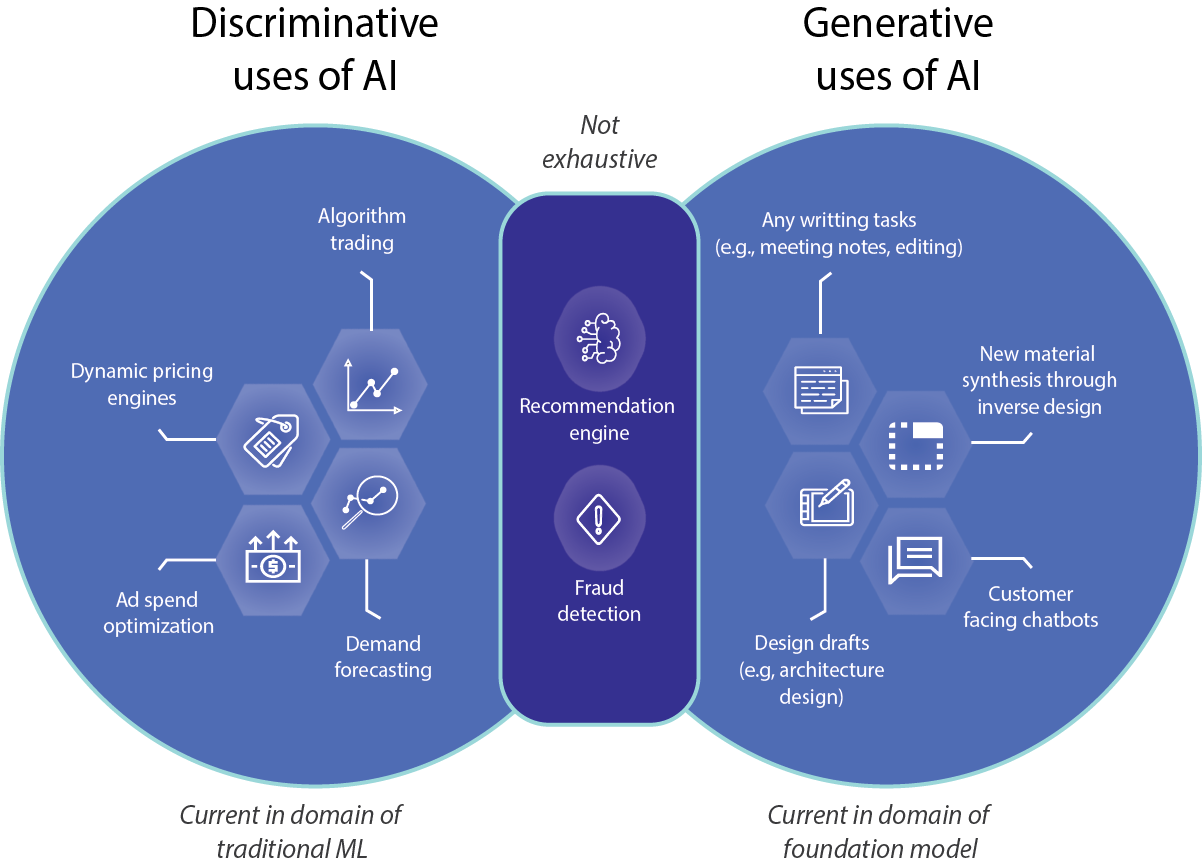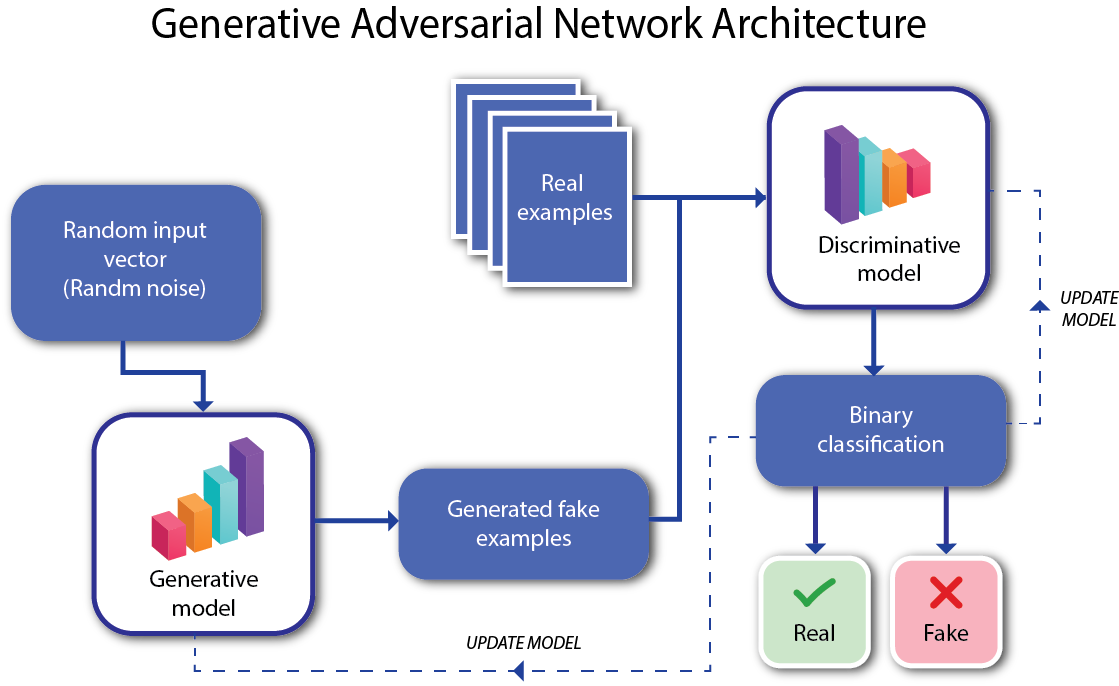

Artificial intelligence (AI) and machine learning (ML) have long been transformative forces in business, revolutionizing operations and decision-making. However, the emergence of generative AI (GAI) marks a new age requirement. Generative AI goes beyond analysis to create new and original content, opening unparalleled opportunities for innovation and creativity.
Generative AI technology has seen remarkable advancements with popular models like GANs, VAEs, autoregressive models, and transformer models. GANs employ competition to create realistic data; VAEs encode and decode for control; autoregressive models generate sequential data; and transformer models capture complex dependencies.
These models drive innovation, pushing the boundaries of what is achievable in business efficiency. By implementing generative AI, your business can generate personalized experiences, fuel the development of intelligent assistants and reshape industries.
According to Gartner, by 2025, 10% of all global data produced will come from generative AI.
This blog delves into the advancements and distinctions of generative AI compared to traditional ML, highlighting the challenges it can proficiently solve. It discusses various components of generative AI, including LLMs, fine-tuning and LLMOps. It also explains how they drive innovation and efficiency. Real-world applications and the benefits of generative AI are explored, along with an adoption plan for successful integration and ethical considerations.
Traditional ML vs. Generative AI: Unveiling the evolution of AI models
| Traditional ML | Generative AI/Foundation Models | |
| Approach | Uses supervised or unsupervised learning algorithms to make predictions based on patterns in training data | Generates new data based on patterns learned from training data |
| Purpose | Focuses on solving specific tasks, such as classification or regression | Primarily used for creative tasks, such as text generation, image synthesis, or music composition |
| Data Requirements | Requires labeled training data for supervised learning or unlabeled data for unsupervised learning | Needs a large amount of training data to learn patterns and generate new content |
| Limitations | Relies on explicit rules or predefined features | Capable of learning complex patterns and generating novel content, but may lack interpretability |
| Flexibility | Less flexible in adapting to new data or tasks | More adaptable and can generate diverse outputs based on input variations |
| Training Time | Training time depends on the complexity of the ML model and the amount of data | Training generative AI models can be computationally intensive and time-consuming |
| Output | Produces predictions or insights based on existing data | Generates new and unique content based on learned patterns |
| Use Cases | Applications in areas such as predictive analytics, fraud detection, and recommendation systems | Used in creative fields, language generation, virtual assistants, and content creation |
While you read about the distinctions between traditional machine learning (ML) and generative AI, it’s essential to what is generative AI and how it works. To understand the revolutionary concept of generative AI and its profound impact on the field of artificial intelligence, let us delve deeper into what generative AI entails and how it functions in comparison to traditional machine learning approaches.
What is generative AI and how it works
Generative AI is a branch of artificial intelligence that leverages algorithms and neural networks to create authentic and human-like content, such as text, images and music. It analyzes patterns in extensive training data and generating new content that closely resembles human creations.
Popular models in generative AI include large language models (LLMs) like GPT-3 and fine-tuning techniques that specialize the models for specific tasks or domains. With the support of large language model operations (LLMOps), generative AI opens transformative possibilities for businesses, allowing them to thrive in competitive environments by automating content creation processes and delivering unique experiences to customers.
Models such as GPT-3, a powerful LLM, form the backbone of generative AI. These models are trained on vast amounts of data to understand language patterns and generate coherent and contextually relevant text.
Additionally, fine-tuning techniques enable models to specialize in specific domains, improving the quality and relevance of the generated output. With the support of LLMOps, businesses can harness the potential of generative AI to automate content creation, optimize resource allocation and differentiate themselves in the market, while ensuring responsible and ethical use of these technologies.
Some of the top generative AI models and their common uses:
- GPT-3 (Generative pre-trained transformer 3): Used for natural language processing tasks such as language generation, chatbots, text completion and content generation.
- StyleGAN (Style-generative adversarial network): Used for generating high-quality and realistic images, image synthesis, visual effects, and deepfake generation.
- VQ-VAE (Vector quantized variational autoencoder): Used for image and video generation, image synthesis, video prediction, and music generation.
- DALL-E: Used for generating unique and imaginative images based on textual prompts, art generation and creative visual content creation.
- MuseNet: Used for music generation, creating original compositions across different genres, and generating musical ideas.
- Pix2Pix: Used for image-to-image translation tasks such as turning sketches into realistic images, day-to-night image conversion and black-and-white to color image transformation.
- CycleGAN: Used for unsupervised image-to-image translation, style transfer, domain adaptation and object transfiguration.
- DeepArt: Used for merging artistic styles, applying the style of a particular painting or artist to user images and creating visually appealing compositions.
- Seq2Seq (sequence-to-sequence models): Used for tasks involving sequential data, including machine translation, text summarization, speech recognition and chatbot responses.
- ProGAN (Progressive Growing of GANs): Used for generating high-resolution images progressively, refining low-resolution images and producing realistic results.
Having explored the inner workings of generative AI and its unique capabilities, let us now turn our attention to the myriad of challenges that this ground-breaking technology can effectively address and overcome.
What challenges can generative AI solve?
- Longer wait times and potential customer dissatisfaction: When you rely on human customer service representatives to answer questions and resolve can cause delays and diminished loyalty.
- Slower product development and competitiveness challenges: Depending solely on human creativity and innovation for developing new products and services can slow down the process and hinder your competitiveness.
- Undetected frauds and financial losses: Relying on human analysts to detect fraudulent transactions can lead to undetected frauds and significant financial losses for your business.
- Slower innovation and market entry: If you depend solely on human employees for conducting research and development, it can slow down innovation and hinder your market entry.
- Impact on the bottom line: Limiting decision-making to human judgment alone, without leveraging the power of AI technology, can significantly and adversely impact your bottom line.
However, when it comes to overcoming these challenges, generative AI emerges as a customized solution that drives innovation and efficiency. It improves decision-making across various aspects of your operations. But before delving deeper into its potential, let’s first understand what exactly generative AI is.
What are the benefits of leveraging generative AI for businesses
Enhanced product development: Generative AI empowers you to accelerate and enhance product development processes. It can generate design variations, prototypes and simulations, allowing you to explore a wide range of possibilities, iterate quickly, and optimize your products for improved performance, functionality and customer satisfaction.
Cost and time savings: By automating certain tasks and generating synthetic data, generative AI can help you reduce costs and save time. It eliminates the need for manual data generation, reduces reliance on physical prototypes, and streamlines iterative design processes. This enables you to bring products to market faster and more efficiently.
Personalized customer experiences: Generative AI enables you to deliver personalized customer experiences by capturing individual preferences and generating tailored recommendations, content, or products. This personalization can increase customer satisfaction, engagement and loyalty This ultimately drives repeat business and long-term customer relationships.
Operational efficiency: Generative AI can improve operational efficiency by automating tasks, optimizing processes and providing valuable insights. It can help you identify bottlenecks, streamline workflows and make data-driven decisions.
Data-driven decision making: With generative AI’s ability to generate scenarios, forecasts, and insights based on data, you can make more informed and data-driven decisions. It provides you with valuable information to understand trends, anticipate market shifts, optimize resource allocation, and mitigate risks, enhancing your strategic planning and decision-making processes.
Innovative marketing and advertising: Generative AI can revolutionize your marketing and advertising efforts. It can generate creative content, personalized recommendations and targeted campaigns. Moreover, it helps you deliver impactful messaging, engage your target audience and maximize the return on your marketing investments.
Improved risk management: Generative AI can assist in risk management by generating synthetic data for testing, simulating potential scenarios, and identifying anomalies or outliers. It helps you assess and mitigate risks, enhance cybersecurity measures, and ensure the integrity and reliability of your systems and operations.
Enhanced customer insights: Generative AI enables you to gain deeper insights into customer preferences, behaviors, and market trends. It helps you understand customer sentiment and identify emerging patterns. Also, it enables you to uncover valuable insights for product development, marketing strategies, and customer service improvements.
Scalability and flexibility: Generative AI offer scalability and flexibility, allowing you to adapt to changing business needs. It can handle large datasets, generate content on-demand, and be deployed across various platforms and channels. This enables you to scale your operations, reach wider audiences and meet evolving customer demands.
Competitive advantage: By leveraging generative AI, you can gain a competitive edge in your industry. It allows you to innovate, differentiate your products or services, and offer unique features or customization options that set you apart from competitors. This can attract new customers, increase market share and position your business as a leader in your field.
Now that we have discussed the benefits of generative AI, let’s delve into the world of LLM models and explore their capabilities.
What are LLM models and how does it work?
LLMs in generative AI work together by leveraging the language generation capabilities of LLMs. They are trained on extensive text data using deep learning techniques. They capture linguistic patterns and structures, enabling them to generate human-like text based on given prompts.
40% of working hours across industries can be impacted by large language models (LLMs) like GPT-4. Language tasks account for 62% of total worked. Of the overall share of language tasks, 65% have high potential to be automated or augmented by LLMs. – Accenture Research
Generative AI utilizes LLMs to automate language-related tasks such as chatbot interactions, language translation and text summarization. LLMs can also be fine-tuned on specific tasks, adapting them to targeted requirements.
All in all, LLMs in generative AI facilitate automated content generation, personalized experiences and improved language tasks. However, ethical considerations and bias mitigation should be considered when deploying LLMs in real-world applications. Also, LLMs excel at tasks that chatbots can perform, like language translation and text summarization, showcasing their remarkable language generation abilities.
Additionally, fine-tuning techniques enable the models to specialize in specific domains, improving the quality and relevance of the generated output. With LLMOps, businesses can harness the potential of generative AI to automate content creation, optimize resource allocation, and differentiate themselves in the market, while ensuring responsible and ethical use of these technologies.
With an understanding of LLM models, let’s now explore the diverse applications where generative AI can make a significant impact.
Different types of applications of generative AI and its examples
| Types of generative AI applications | Descriptions | Examples of applications |
| Text Generation | Generates human-like text based on input prompts or context. | Language translation, content generation, chatbot interactions |
| Image Generation | Generates realistic or abstract images from scratch or based on given input. | Image synthesis, artistic style transfer, image-to-image translation |
| Data Augmentation | Generates synthetic data samples to augment existing datasets for training machine learning models. | Data augmentation, improving model performance |
| Music Generation | Creates original music compositions or generates music in a specific style or genre. | Music composition, audio synthesis, sound generation |
| Video Generation | Generates new videos or modifies existing videos by altering scenes, objects, or visual elements. | Video synthesis, video completion, video prediction |
| 3D Model Generation | Generates 3D models and objects, allowing for the creation of new designs, virtual environments, and simulations. | 3D modeling, virtual reality, simulation development |
| Speech Generation | Generates human-like speech and can be used for text-to-speech synthesis, voice assistants, and automated voice systems. | Voice assistants, automated voice systems |
Now that you have explored the different types of applications of generative AI and its examples, let’s shift our focus to the key considerations for successfully adopting generative AI within your organization.
How can your organization successfully adopt generative AI
To successfully integrate generative AI into your organization, follow this adoption plan:
1. Understand your business landscape: Assess your organization’s needs, challenges and goals to identify areas where generative AI can provide value.
2. Research and explore: Explore this technology, platforms and success stories to evaluate their capabilities and compatibility with your systems.
3. Define use cases: Identify specific use cases in your industry where generative AI can make a significant impact.
4. Collaborate with experts: Engage with AI specialists to develop a tailored adoption plan and roadmap.
5. Ensure data readiness: Assess data availability, infrastructure, governance and security to support generative AI.
6. Conduct proof of concept: Validate generative AI’s feasibility and potential impact in a controlled environment.
7. Implement and integrate: Develop a comprehensive implementation plan, involving stakeholders and IT teams.
8. Train and upskill: Invest in training programs to empower your workforce with generative AI skills.
9. Continuously monitor and optimize: Regularly evaluate performance, refine models and adapt to changing needs.
10. Plan for scalability: Design a flexible architecture to accommodate growth and future advancements in this technology.
By following this plan, you can integrate generative AI effectively, unlock its transformative potential, and seize futuristic opportunities in your industry.
Key challenges of generative AI implementation
As you embark on the journey of implementing generative AI, you must be mindful of the challenges that come with it.
- Addressing bias: Ensure that the generated content remains unbiased by actively managing and mitigating any potential biases in the AI model’s training data and algorithms.
- Copyright infringement: Take measures to prevent the generation of content that infringes on copyrights. Implement mechanisms to ensure the AI-generated content is original or properly licensed.
- Data privacy concerns: Safeguard data privacy by adhering to regulations and implementing robust security measures when collecting, storing, and utilizing data for training generative AI models.
- Security risks: Mitigate security risks associated with generative AI models by implementing stringent security protocols to protect against potential attacks and unauthorized access to sensitive data.
By proactively addressing these challenges, your business can pave the way for a successful and responsible implementation of generative AI use cases, unlocking its potential for innovation and growth while ensuring ethical and compliant practices.
In conclusion
In this fast-paced and evolving technological landscape, you need to embrace generative AI to stay ahead of the competition. By overcoming challenges, seizing opportunities and harnessing the power of generative AI, you can position your business for success and thrive in the dynamic world of AI-driven innovation.
By partnering with a generative AI consulting services provider, you can benefit from their experience and domain knowledge. You can access cutting-edge technologies, receive ongoing support, and stay ahead of the curve in this rapidly evolving field. Get in touch with our experts in generative AI technology to accelerate the implementation process and help your business achieve strategic objectives.
Need Help ?
We are here for you

